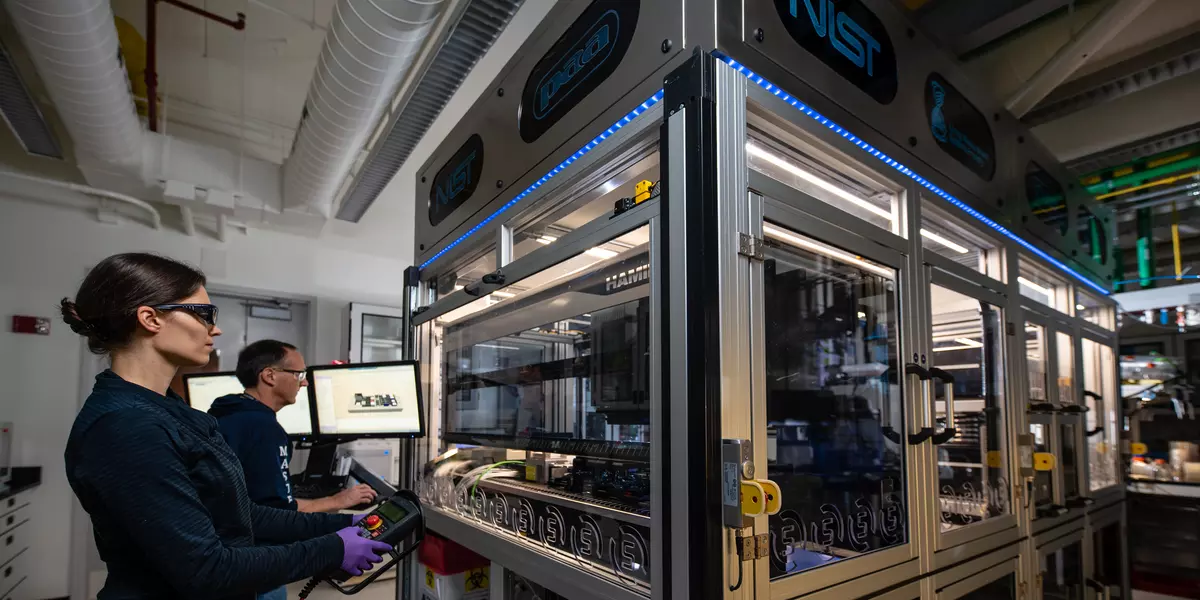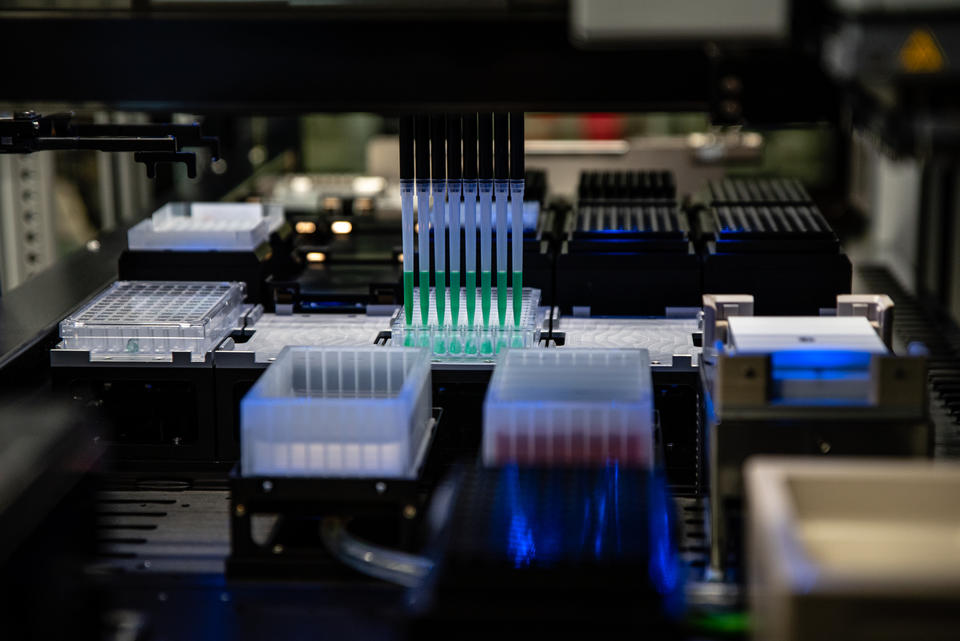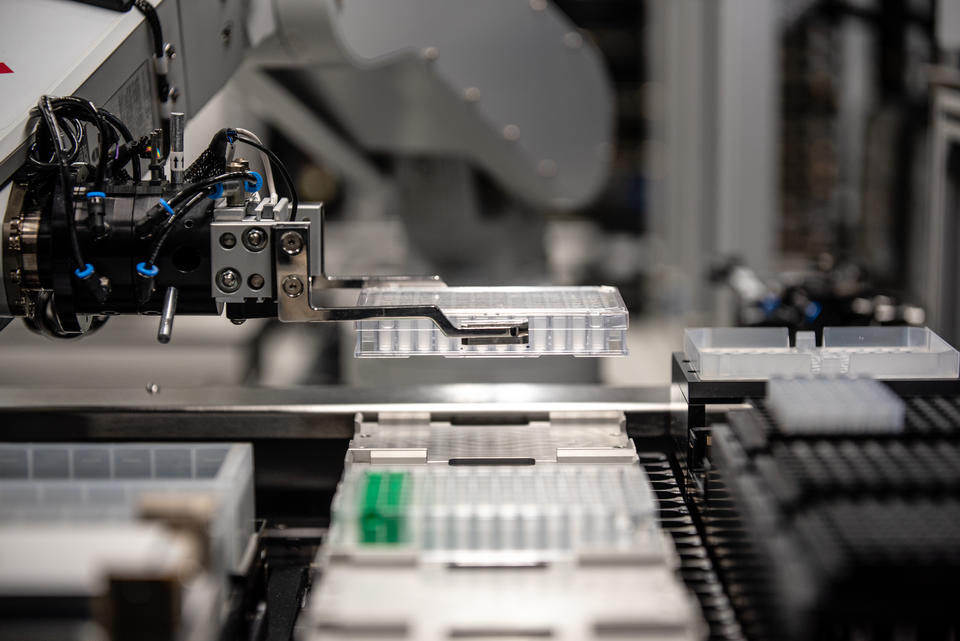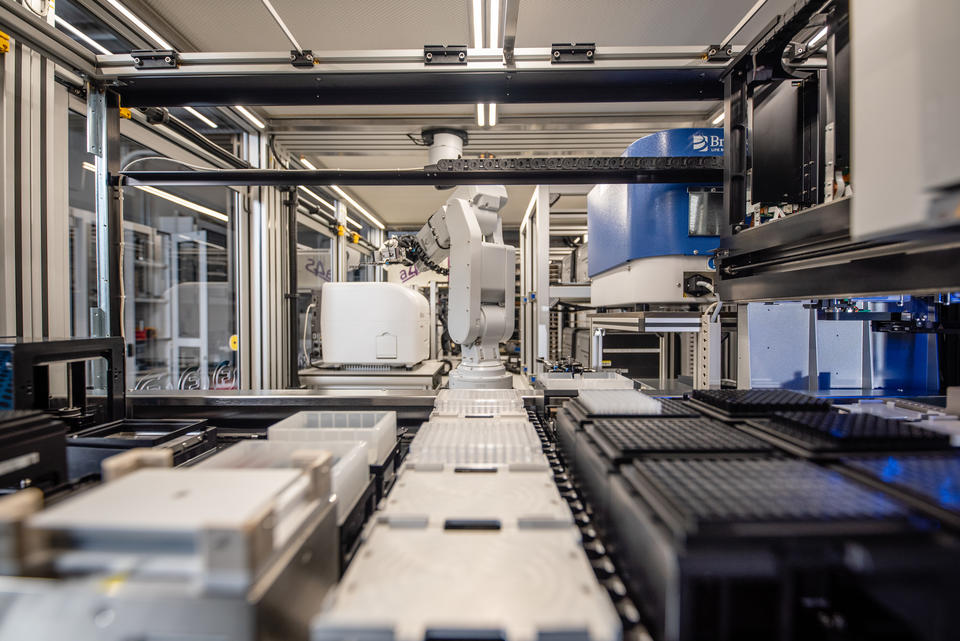
Elizabeth Strychalski and David Ross program the movements of the main robotic arm in the NIST Living Measurement Systems Foundry. Biofoundries like this make it possible to engineer living cells so that they produce specific medical treatments or chemical products. The NIST biofoundry is helping to advance the measurement science that will ensure these processes are reliable.
The NIST Biofoundry: Taking Engineering Biology From Artisanal to Automated
All over the world, people are engineering biological systems to solve problems. Some want to find environmentally sustainable ways to mimic natural resources. Some want to build new kinds of medical treatments for deadly diseases. Others want to grow more productive crops. The promise of such work is enormous.
But when physicist David Ross thinks of these things, he thinks a lot about primitive people busting rocks to make tools.
“That’s pretty much where we are now with engineering biology. The way we engineer these kinds of systems is really like building a stone wall with found stone,” he says. “But what we want to be able to do is enable the building of the Roman aqueduct, which requires precise measurement and precise cutting and shaping of the stone.”
Already, scientists can engineer cells to produce chemicals or cure previously untreatable diseases. But there’s not enough information available for anyone to be able to scale up easily and safely, which limits the ability to make cell products for wide distribution. Manufacturers and the public want to know that whatever is made via engineering biology will be safe and reliable. What’s needed are accurate and reliable measurements.
Just as Newton’s laws of motion and calculus laid the foundations that enabled humans to move toward precision manufacturing and eventually computer-aided design and drafting, measurements that lead to more precise and comprehensive DNA sequencing could potentially lay the groundwork for the projects that Ross and others dream of accomplishing.
But for engineering biology to really succeed, Ross says, we need foundries. Specifically, we need biofoundries like the Living Measurement Systems Foundry (LMSF) that he runs at the National Institute of Standards and Technology (NIST) in Gaithersburg, Maryland.
A traditional foundry allows people to pour molten metal into different molds in order to make products, he explains. A biofoundry allows people to remake or redesign raw living materials into new products. It allows researchers to experiment with cells, adjusting their genetic codes and molecular machinery until we can predictably engineer a cellular system to do exactly what we want it to do.
An ‘Oddly Satisfying’ Reliance on Machine Learning
While Ross explains this to visitors at his lab, his own biofoundry purrs away within a large plexiglass box that resembles a giant fish tank or the “grabber machine” you might find on the boardwalk at the beach, where you put in a dollar and try to use robotic arms to grab prizes. Every few seconds, a sleek row of pipettes is whisked from one side of the biofoundry to the other. The pipettes dip down in a dainty, precise way, like miniature ballerinas in toe shoes. Specimens are sucked up and moved to new plates for sampling. It is all quite soothing, so much so that video of this new NIST biofoundry at work has found viewers online via the popular social media hashtag #OddlySatisfying.
In the same way that early metalwork foundries led to assembly lines and automation in factories, biofoundries aim to automate biology. Engineering biology can enable a predictable and reliable way to design biologically related processes and products for public benefit. Among other things, this could include advances in materials manufacturing, medicine, sustainable energy and agriculture.
The plan is to have the NIST biofoundry rely on machine learning, which is part of the larger field of artificial intelligence (AI). One day, the lab’s robotic arms will be given a set of tasks, and then set to work for weeks or even months at a time, testing and retesting large numbers of cells that have been manufactured to achieve a specific goal.
At this point, so little is known about bioengineering cells that all data is welcome. A machine like the NIST biofoundry can push through more samples at a time and do so more precisely than any human could. Ideally, it will one day be used to test new and different things or assess when an experiment should change and make the adjustment on its own. All of this could help to increase the speed of new discoveries by leaps and bounds for the humans behind the programming.
“We’re at the cutting edge in unexpected ways,” says NIST physicist Elizabeth Strychalski. “We are having to solve problems that we would like to take for granted.” Some of those issues are related to the physical integration of the biofoundry parts. Some are software related, like programming across different environments and in a way that will allow for the large-scale computations of machine learning. There’s a certain element of being the first ones to try things, she adds, that is exciting and frustrating at the same time.
"We’re at the cutting edge in unexpected ways. We are having to solve problems that we would like to take for granted.” —Elizabeth Strychalski, NIST physicist
In February, Strychalski co-authored a paper titled Organizing Genome Engineering for the Gigabase Scale for Nature Communications. In it, she and her fellow authors outlined some of the changes that must take place in the field of biology to scale up engineering, for example before building with an organism’s entire genome can be accomplished regularly and confidently.
One key to success, she feels, is better large-scale collaborations. Right now, she says, biology is struggling to support large partnerships. As she argues in her paper, significant challenges make sharing the flow of models, designs, materials and measurements across teams prohibitive at this point.
“A lot of the approaches and the mindset from industrial engineering are only now getting mapped on biological systems and engineering,” says Strychalski. “Most chemistry and biology labs have looked the same for over 100 years, with rows and rows of benches with people and pipettes. It is just now that automation is becoming more of an option and more attractive.”
“We need to find new ways to approach biology,” says biochemist Drew Tack, who works with Ross and Strychalski. Tack, now in his third year as a postdoctoral researcher in the biofoundry lab, first became interested in engineering biology when he was working on his bachelor’s degree. He foresees a future where “we will have tools all over the world to monitor our health, our environment, everything. They will be seamlessly integrated into our lives.” He is excited to be part of that transformation.
Having physicists at work on the project has been a tremendous asset, Tack adds, because they are experienced with large-scale quantitative problems and large-scale data analysis. It has helped him realize some of the current shortcomings of biology. “What we have been doing has often worked but may be limiting our results.”

Within the NIST Living Measurement Systems Foundry, an automated liquid handler transfers samples between 96-well plates for testing.
The Programmable Laboratory
The NIST biofoundry includes a fully integrated, high-throughput system that can automate common tasks in the engineering biology workflow, such as handling liquids, incubation of samples, multi-well plate measurements, electro-transformation and centrifugation. Put more simply, the facility can run thousands of experiments in a short amount of time, providing the data needed to determine if a complicated piece of biological experimentation will work predictably every time.
The system was designed to be shared with those outside of the agency, including industry, academic and government collaborators. Almost immediately, the NIST biofoundry was put to use by an outside collaborator from another federal agency.
“Many different countries have realized that the bioeconomy is going to be very important for their economy going forward,” says Nathan Hillson, co-chair of the Global Biofoundries Alliance (GBA) steering committee and software working group. “These biofoundries, including public biofoundries, are engines for accelerating the bioeconomy.”
So far, 25 biofoundries around the world have joined the GBA, which was established in 2019.
"Many different countries have realized that the bioeconomy is going to be very important for their economy going forward. These biofoundries, including public biofoundries, are engines for accelerating the bioeconomy.” —Nathan Hillson, co-chair of the Global Biofoundries Alliance
Hillson, who is a staff scientist at the Lawrence Berkeley National Laboratory in California, thinks it is important to stay aware of what other similar labs are doing. Standards will likely be set in the coming years for engineering biology, and he sees a role for the U.S. labs. “NIST is going to be super important as a contributor,” he says.
Not every biofoundry is automated like the one at NIST. Eric Klavins runs a biofoundry at the University of Washington that is run by executable protocols, with humans doing the tasks in a manner precisely prescribed by code.
“It is a human-in-the-loop system,” Klavins says, noting that the humans are often undergrads, who need no knowledge of the experiment whatsoever. “We think of it as a programmable laboratory. Inside, there are people following meticulous instructions.”
Klavins earned a Ph.D. in computer science almost 20 years ago and began his career with a focus on manufacturing, but soon after he became fascinated with engineering organisms. He quickly discovered that biology experiments were hard to do, and hard to reproduce. He became interested in the ways that automation might help with reproducibility. Like Ross and Strychalski at NIST, he is working in biology with a non-bio perspective.
“I think a biofoundry is defined by the materials and the data that go in and the materials and data that come out,” Klavins says. Fully automated systems like the one at NIST tend to be less flexible than the systems that have humans in the loop, he notes, but they can complete more work in less time. A fully automated robotic system also may scale up in a way that a system like Klavins’ can’t. On the other hand, automated systems like the NIST biofoundry will also have a longer development time, he notes, which may be prohibitive for academics like himself.
The GBA allows people to learn from each other, Klavins says, which he sees as very valuable. Although a relatively new organization, GBA will keep “us all from re-inventing the wheel,” he foresees. “And if somebody has invented an entirely new tool, we’ll all know about it.”

Machine learning will allow the NIST Living Measurement Systems Foundry to use all the data it collects over multiple experiments to automatically choose the best next set of measurements to achieve different engineering goals.
Producing New Kinds of Cells
The NIST biofoundry differs from others because of its focus on cells as products. Other biofoundries emphasize increasing the rate and scale at which the DNA inside cells can be edited. Some in the private sector have focused on the economically valuable chemicals that cells can be designed to make. There are commercial labs, for example, that produce cells that make substitutes for rare, high value ingredients in perfumes. Other government labs, such as those in the Department of Energy, have been focused on producing cells that can be used to make alternative biofuels. Most of these needs are already marketable, and in demand.
The NIST biofoundry, however, is focused on what might be useful two or more years from now, as the field of biology expands. “We wanted to anticipate needs,” Ross says. “So, we are working toward having the cell itself be the product of value, not just a production platform.”
Hypothetically, that could include producing cells that could act as sensors. Such cells could be placed in a patient and be autonomous, acting to cure diseases or treat recurring problems as they happen.
Researchers working on Alzheimer’s treatments might be able to give patients specific nutritional supplements via cell sensors. Diabetes could be treated by adjusting the microbiomes of individual patients to precisely control their insulin levels. Other researchers want to enable those born with a rare inherited disorder called PKU to safely eat regular foods without fear of serious repercussions.
A biofoundry helps determine measurement questions, such as which parts of the DNA might need to be changed to get the cells to do the correct work reliably in a person’s body. It also makes measurements regarding the effectiveness of those changes. And then it can test for reproducibility, by repeating measurements many times.

Robotic arms move within the NIST Living Measurement Systems Foundry, ferrying samples between different instruments for testing and analysis.
Admittedly, Ross and Strychalski are not focused on the details of the biology behind PKU, cancer treatments, or insulin’s effect on the human body. They bring a measurement scientist’s approach to the entire situation and work with the foundry from that perspective. Ross sees himself as enabling the bioengineers to make discoveries quickly and efficiently.
That means understanding what to measure in the cells. As with all other forms of science, you can’t understand and control something if you don’t know how to measure it and evaluate it. Without those measurements, many advanced cell products and therapies will remain elusive and hypothetical.
The goal, Ross says, is not to have the biofoundry be a factory. The cells are supposed to be the factories. He’s trying to figure out what is needed to make it so. This means the NIST biofoundry will provide something different from many other automated and nonautomated systems. These systems may work well for those who want to design a cell that can perform a task. But for that to happen you have to do thousands of measurements. What the NIST system explores is the question: What do we need to measure?
“Before this idea of engineered cells as products can be realized on a large scale, we need to build the measurement infrastructure,” Ross says.

